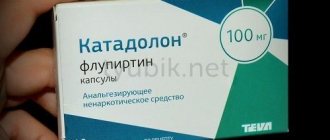Contraindications
Unfortunately, there are a number of restrictions on the use of Katadolon. The following conditions are contraindications for use:
- Intolerance to the drug and its components.
- Liver diseases, including previous ones.
- Tinnitus.
- Gallstone disease with symptoms of cholestasis.
- Myasthenic syndrome.
- Alcoholism.
- Pregnancy and lactation.
- Children's age (up to 18 years).
Use with caution in older patients.
Dosage
The dosage should be selected by a neurologist. The frequency of administration, as well as the choice of prescribing the drug Katadolon or Katadolon forte, depends on many parameters.
As a rule, treatment of the disease begins with taking the drug Katadolon 100 mg 3 times a day. With severe symptoms of the disease, the total daily dosage can reach 600 mg (200 mg 3 times a day).
In elderly patients, the start of therapy is a double dose of the drug at a dose of 100 mg 2 times a day. If the analgesic effect is insufficient and the drug is well tolerated, the total daily dose can be increased to three hundred mg.
When using the drug Katadolon forte, a single dose of 1 tablet in the morning is recommended.
The course of treatment is determined by the effectiveness of the drug, the severity of the manifestations, taking into account the individual characteristics of the patient and is selected by the doctor. Long-term use of the drug is a reason to monitor the main biochemical parameters of the liver and kidneys.
Catadolon capsules 100 mg 30 pcs.
Flupirtine is a member of the Selective Neuronal Potassium Channel Opener (SNEPCO) class of drugs. In terms of its pharmacological effects, the drug is a non-opioid analgesic of central action, which does not cause dependence or addiction; in addition, it has a muscle relaxant and neuroprotective effect. The action of flupirtine is based on the activation of voltage-independent potassium channels, which leads to stabilization of the membrane potential of the neuron. The effect on the current of potassium ions is mediated by the effect of the drug on the regulatory G-protein system. The analgesic effect is based both on indirect antagonism towards NMDA (N-methyl-D-aspartate) receptors, and through modulation of pain mechanisms associated with the effect on GABAergic systems. At therapeutic concentrations, flupirtine does not bind to alpha1-, alpha2-adrenergic receptors, serotonin 5HT1, 5HT2 receptors, dopaminergic, benzodiazepine, opiate, central muscarinergic or nicotinergic receptors. The central action of flupirtine is based on 3 main effects: Analgesic effect. Flupirtine activates (opens) voltage-independent potassium channels, which leads to stabilization of the membrane potential of the nerve cell. In this case, the activity of NMDA receptors is inhibited and, as a consequence, the blockade of neuronal calcium ion channels and a decrease in the intracellular current of calcium ions occurs. Due to the developing suppression of neuron excitation in response to nociceptive stimuli, inhibition of nociceptive activation, an analgesic effect is realized. In this case, the growth of the neuronal response to repeated painful stimuli is inhibited. This action prevents pain from intensifying and becoming chronic, and in case of existing chronic pain syndrome, it leads to a decrease in its intensity. The modulating effect of flupirtine on the perception of pain through the descending noradrenergic system has also been established. Muscle relaxant effect. The antispastic effect on muscles is associated with blocking the transmission of excitation to motor neurons and interneurons, leading to the relief of muscle tension. This effect of flupirtine occurs in many chronic diseases accompanied by painful muscle spasms (musculoskeletal pain in the neck and back, arthropathy, tension headaches, fibromyalgia). Neuroprotective effect. The neuroprotective properties of the drug determine the protection of nervous structures from the toxic effects of high concentrations of intracellular calcium ions, which is associated with its ability to cause blockade of neuronal calcium ion channels and reduce the intracellular current of calcium ions.
Overdose
Symptomatically, an overdose of Katadolon is manifested by nausea, deterioration of general condition, impaired consciousness, emotional lability, and retardation of psychomotor reactions. Emergency help for an overdose of flupirtine consists of gastric lavage, prescribing adsorbents, and carrying out forced diuresis measures. There is no specific antidote.
Cases of deliberate intake of flupirtine in a dose of about 5 grams (50 capsules or approximately 13 tablets of Katadolon-Forte) have been described. Symptoms included nausea, rapid heartbeat, stupor, and dry mouth. After nonspecific therapy, the patient’s well-being improved, and there was no threat to vital functions.
special instructions
When taking Katadolon in patients with impaired liver and kidney function, it is important to monitor the relevant biochemical indicators of the functioning of these organs. You should remember about possible changes in reactions to the content of bilirubin and its metabolites in urine and blood. With prolonged use of the drug, especially in high doses, urine may turn greenish.
Catadolon may potentially lead to a decrease in the speed of psychomotor reactions. During treatment, you should limit driving and performing other potentially hazardous activities. You should also remember about the possible enhancement of the sedative effect when taken simultaneously with alcohol, muscle relaxants, and sedatives.
In elderly patients, patients with decreased levels of total protein, patients with severe renal or hepatic insufficiency, the maximum daily dose should not exceed 200-300 mg, divided into 2-3 doses.
The simultaneous use of Katadolon and other drugs that undergo metabolism in the liver should be limited. Particular attention in terms of the treatment of neurological diseases is given to the combined use of catadolone and finlepsin (carbamazepine), paracetamol.
Instructions for use KATADOLON® (KATADOLON)
Non-opioid analgesic of central action. Flupirtine is the prototype of a new class of substances SNEPCO (Selective Neuronal Potassium Channel Opener - selective activators of neuronal potassium channels). Refers to non-opioid analgesics of central action that do not cause dependence or addiction.
Flupirtine has analgesic, muscle relaxant and neuroprotective effects based on indirect antagonism of NMDA (N-methyl-O-aspartate) receptors, activation of descending mechanisms of pain modulation and GABAergic processes. At therapeutic concentrations, flupirtine does not bind to α1-, α2-, 5HT1-, 5HT2-, dopamine, benzodiazepine, opioid, central m- or n-cholinergic receptors.
Analgesic effect
Flupirtine in therapeutic doses activates (opens) voltage-independent potassium channels, which leads to stabilization of the membrane potential of the nerve cell. In this case, the activity of NMDA receptors is inhibited and, as a consequence, blockade of neuronal calcium ion channels, a decrease in the intracellular current of calcium ions, and inhibition of neuron excitation in response to nociceptive stimuli (analgesia). As a result of these processes, the formation of nociceptive sensitization (pain sensitivity) and the “wind up” phenomenon (“winding up” - an increase in the neuronal response to repeated painful stimuli) is inhibited, which prevents pain from increasing, its transition to a chronic form, and in case of existing chronic pain syndrome leads to a decrease in its intensity. The modulating effect of flupirtine on the perception (sensitivity) of pain through the descending noradrenergic system has also been established.
Muscle relaxant effect
The antispastic effect on muscles is associated with blocking the transmission of excitation to motor neurons and interneurons, leading to the relief of muscle tension. This effect of flupirtine occurs in many chronic diseases accompanied by painful muscle spasms (musculoskeletal pain in the neck and back, arthropathy, tension headaches, fibromyalgia).
Neuroprotective effect
The neuroprotective properties of the drug determine the protection of nervous structures from the toxic effects of high concentrations of intracellular calcium ions, which is associated with its ability to cause blockade of neuronal calcium ion channels and reduce the intracellular current of calcium ions.
Side effects
The drug is quite safe and well tolerated. The main side effects are as follows:
- General weakness, fatigue, dizziness, gastrointestinal problems (heartburn, nausea, less commonly vomiting, indigestion, flatulence), sweating are common and very common.
- Allergic reactions and individual intolerance to the drug and its components are relatively rare.
- Rarely and very rarely, increased activity of liver enzymes, drug-induced liver damage, disturbances of consciousness, hearing and vision impairment were observed.
Almost all side effects are dose-dependent. Timely dose adjustment or discontinuation of the drug led to the disappearance of all side effects.
Katadolon®
Selective activator of neuronal potassium channels. In terms of its pharmacological effects, the drug is a non-opioid analgesic of central action, which does not cause dependence or addiction; in addition, it has a muscle relaxant and neuroprotective effect.
The action of flupirtine is based on the activation of voltage-independent potassium channels, which leads to stabilization of the membrane potential of the neuron. The effect on the current of potassium ions is mediated by the effect of the drug on the regulatory G-protein system.
In therapeutic doses, flupirtine does not bind to α1-, α2-adrenergic receptors, serotonin 5HT1-, 5HT2-receptors, dopamine, benzodiazepine, opioid, central m- and n-cholinergic receptors.
The central action of flupirtine is based on 3 main effects.
Analgesic effect
The analgesic effect is based both on indirect antagonism of NMDA receptors and through modulation of pain mechanisms associated with the effect on GABAergic systems.
Flupirtine activates (opens) voltage-independent potassium channels, which leads to stabilization of the membrane potential of the nerve cell. In this case, the activity of NMDA receptors is inhibited and, as a consequence, the blockade of neuronal calcium ion channels and a decrease in the intracellular current of calcium ions occurs. Due to the developing suppression of neuron excitation in response to nociceptive stimuli, inhibition of nociceptive activation, an analgesic effect is realized. In this case, the growth of the neuronal response to repeated painful stimuli is inhibited. This action prevents pain from intensifying and becoming chronic, and in case of existing chronic pain syndrome, it leads to a decrease in its intensity. The modulating effect of flupirtine on the perception of pain through the descending noradrenergic system has also been established.
Muscle relaxant effect
The antispastic effect on muscles is associated with blocking the transmission of excitation to motor neurons and interneurons, leading to the relief of muscle tension. This effect of flupirtine occurs in many chronic diseases accompanied by painful muscle spasms (musculoskeletal pain in the neck and back, arthropathy, tension headaches, fibromyalgia).
Neuroprotective effect
The neuroprotective properties of the drug determine the protection of nervous structures from the toxic effects of high concentrations of intracellular calcium ions, which is associated with its ability to cause blockade of neuronal calcium ion channels and reduce the intracellular current of calcium ions.




